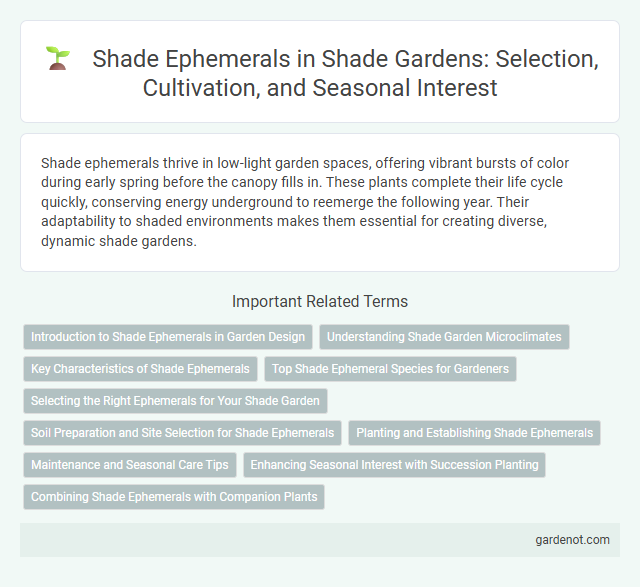Shade ephemerals thrive in low-light garden spaces, offering vibrant bursts of color during early spring before the canopy fills in. These plants complete their life cycle quickly, conserving energy underground to reemerge the following year. Their adaptability to shaded environments makes them essential for creating diverse, dynamic shade gardens.
Introduction to Shade Ephemerals in Garden Design
Shade ephemerals are specialized plants that thrive in low-light environments, completing their life cycle quickly during early spring before tree canopies fully develop. These perennials offer vibrant early-season blooms and lush foliage that enhance garden aesthetics while supporting woodland ecosystems. Incorporating shade ephemerals into garden design maximizes underutilized shaded areas, promoting biodiversity and seasonal interest.
Understanding Shade Garden Microclimates
Shade ephemerals thrive in the unique microclimates created by the interplay of dappled sunlight, soil moisture, and temperature variations beneath tree canopies. These plants have adapted to brief periods of light availability in early spring before deciduous trees fully leaf out, capitalizing on cooler temperatures and higher soil moisture levels. Understanding these microclimate dynamics is essential for successfully cultivating shade ephemerals, ensuring optimal growth and seasonal bloom cycles within shade gardens.
Key Characteristics of Shade Ephemerals
Shade ephemerals thrive in low-light environments, displaying rapid spring growth before the canopy fully develops. These plants possess adaptations such as thin, delicate leaves to maximize photosynthesis during brief sun exposure and often have a short life cycle, completing growth and reproduction within weeks. Their root systems are typically shallow but efficient, enabling quick nutrient uptake in moist, shaded soil.
Top Shade Ephemeral Species for Gardeners
Top shade ephemeral species for gardeners include bloodroot (Sanguinaria canadensis), trillium (Trillium spp.), and spring beauty (Claytonia virginica), renowned for their early spring blooms and shade tolerance. These plants thrive in woodland garden settings, emerging quickly after snowmelt and completing their life cycles before tree canopies fully develop. Selecting shade ephemerals with diverse bloom times and foliage textures enhances garden biodiversity and visual interest during the transient spring season.
Selecting the Right Ephemerals for Your Shade Garden
Choosing the right shade ephemerals for your garden involves selecting plants that thrive in low-light conditions while providing early spring interest. Species such as trilliums, bloodroot, and Virginia bluebells are ideal for their ability to bloom before the tree canopy fully develops, maximizing sunlight capture. Proper soil moisture and well-drained, humus-rich soil are essential factors to ensure healthy growth and prolonged bloom periods in shaded environments.
Soil Preparation and Site Selection for Shade Ephemerals
Shade ephemerals thrive in well-drained, humus-rich soil high in organic matter to support their delicate root systems during brief growth periods. Selecting a site with consistent, dappled sunlight under deciduous trees ensures optimal moisture retention and protects these plants from harsh midday sun. Proper soil preparation involves incorporating leaf mold or compost to mimic the natural forest floor environment, enhancing nutrient availability and soil structure for robust ephemeral growth.
Planting and Establishing Shade Ephemerals
Plant shade ephemerals in early spring when soil temperatures reach approximately 50degF to ensure optimal root establishment before canopy closure. Choose well-drained, humus-rich soil with consistent moisture to support rapid growth during their brief above-ground life cycle. Position these plants in sheltered locations with dappled sunlight to mimic their natural forest floor habitat, promoting vigorous blooms and foliage development.
Maintenance and Seasonal Care Tips
Shade ephemerals thrive with minimal maintenance, requiring consistent moisture and well-drained soil to prevent root rot. Seasonal care involves mulching in fall to insulate roots and applying light fertilizer in early spring to support vigorous growth. Regularly removing spent foliage helps reduce disease risk and encourages healthy new shoots.
Enhancing Seasonal Interest with Succession Planting
Shade ephemerals such as Trilliums, Jack-in-the-pulpit, and Bloodroot thrive in low-light woodland gardens, offering vibrant blooms early in the spring. Succession planting with these ephemeral species ensures continuous seasonal interest by staggering bloom times and layering foliage textures through spring and early summer. Incorporating diverse shade ephemerals enhances ecological value and sustains pollinator activity during their short growing season.
Combining Shade Ephemerals with Companion Plants
Shade ephemerals like Trilliums and Bloodroot thrive when paired with companion plants such as ferns and hostas that provide complementary foliage and moisture retention. These combinations enhance biodiversity while creating layered textures and seasonal interest in the shade garden. Proper plant spacing and soil conditions ensure both shade ephemerals and companions flourish together, promoting healthy growth and natural pest resistance.
Shade ephemerals Infographic

 gardenot.com
gardenot.com